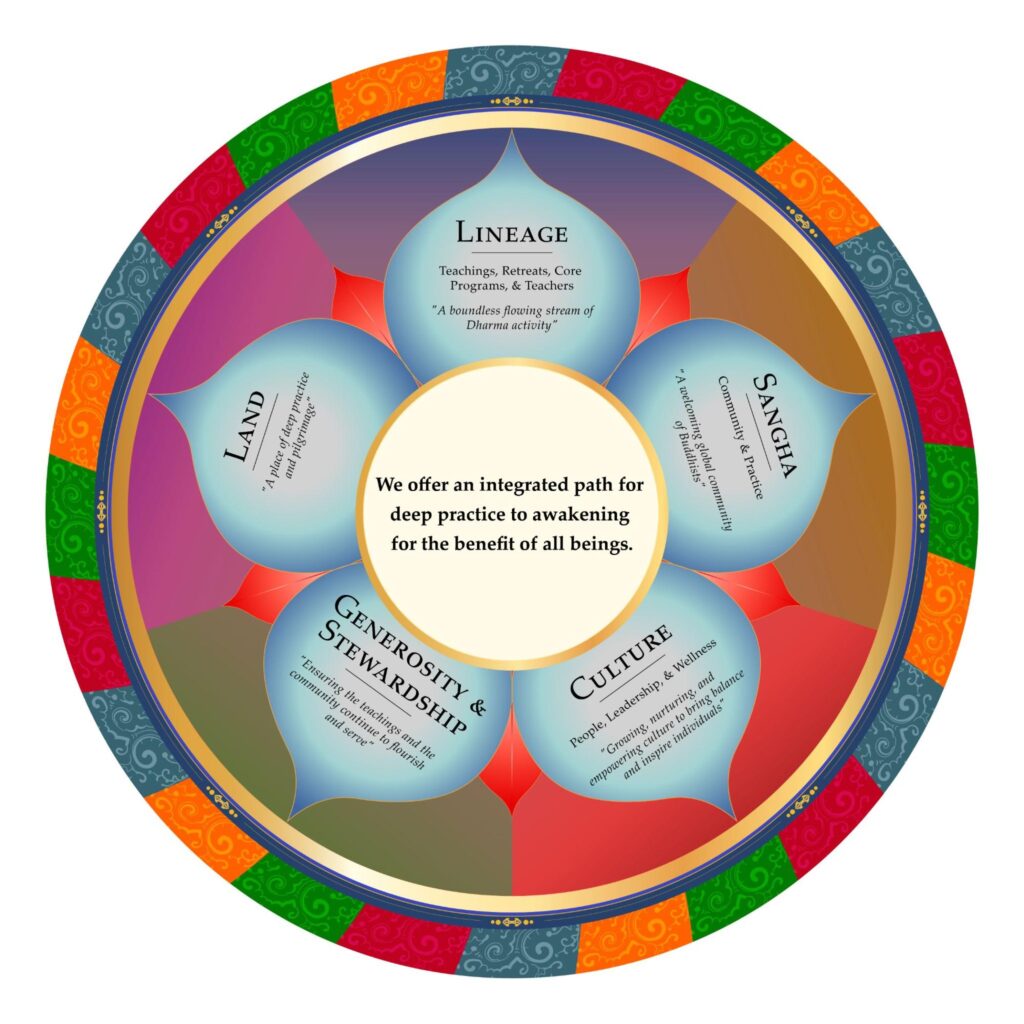Tara Mandala, Inc. was incorporated as a Colorado Nonprofit Corporation in 1994. Tara Mandala is a tax-exempt 501(c)(3) religious organization and church. Tara Mandala is lead by Spiritual Director Lama Tsultrim Allione and managed by its Board of Trustees who follow its bylaws.
Tara Mandala has a rich history of manifestation and development in its first two decades of existence. As we look forward to the next phase of maturation and refinement for the organization, we are pleased to complete a strategic planning process to identify the core priorities that will guide our work in the coming years. Through this strategic planning process, we are committing to short, medium, and long-term goals that align with Tara Mandala’s mission and community values. Today, on November 18, 2016 we present this plan for review to the Board of Trustees.
⠂⠂⠂
Tara Mandala began with Lama Tsultrim’s vision of a retreat center where practitioners in the West could achieve the depths of meditation at the level what was achieved in Tibet. Through synchronicity and spontaneous manifestation, Lama Tsultrim and David Petit found and purchased the retreat center land, with the generosity of donors often coming forward just when needed. Starting with little more than her vision of the Tara Temple, and David’s help, the first structures and buildings were constructed on the land. Beginning with a collection of tents and yurts, Tara Mandala soon built the Community Building, Prajna Residence Hall, four retreat cabins, and in 2009 completed the Trikaya Tara Temple. The physical facilities of Tara Mandala rose improbably, almost magically, through the hard work, generosity, and dedication of Lama Tsultrim, David, the growing sangha, and the many staff and volunteers who worked on the land. Similarly, dharma blossomed on the land through teachings from Lama Tsultrim, visiting Rinpoches, and other teachers who were brought to Tara Mandala. It became to be known as a power place for practice, teachings, and deep retreat. Lama Tsultrim later clarified and organized long-term practice paths for students into what is now established as the Gateway and Magyu lineage programs. Students continued to be drawn to Lama Tsultrim, and Tara Mandala global sanghas sprung up around the country and throughout the world.
This auspicious beginning laid the foundation for the organization and prepared Tara Mandala to enter its next 22-year phase. The bootstrapping boldness of the early days that was necessary to establish and grow Tara Mandala is now giving way to a more formal, robust management and an eye to long term stability and sustainability for the organization.
To ensure its current health and future functioning, Tara Mandala has laid the foundation for a shared, collaborative effort, enabling Lama Tsultrim to develop a team both at Tara Mandala and remotely to whom she can entrust the organization. As the teachings show us, the impermanence of human life is unpredictable and inevitable. Lama Tsultrim and her team are taking pains to ensure that Tara Mandala will not only survive her but thrive in the years after her passing enabling the center to be the seat of her future reincarnations. Looking toward the future, we understand the importance of establishing a management plan and structures to support consistent progress toward the strategic priorities of Lama Tsultrim’s vision in the short, medium, and long term – the culmination of which is this strategic plan.
To this end, Tara Mandala created a Strategic Planning Committee in 2012. In 2013 and 2014, the organization engaged the input of organizational consultants Susan Skeij and Sheldon Romer. The Board of Tara Mandala then looked to Lama Tsultrim’s vision, and together with Lama Tsultrim, wrote updated mission and vision statements for the organization in 2015. In 2016, the Strategic Planning Committee identified the key priorities toward which Tara Mandala can direct and focus its efforts. This committee drafted an original version of this strategic plan and reviewed it with Lama Tsultrim Allione. Next, the committee engaged in a formal process to solicit the feedback of key stakeholders within the sangha of the organization including Senior and Apprentice teachers, national and international Global Sangha leaders, current and past Board Members, current and past Executive Directors, Magyu and Gateway participants, major donors, as well as current and past staff and volunteers. The result of this process is the following six areas of strategic priorities. This list represents the roadmap that will guide Tara Mandala as it transitions from the “establishment” and “start-up” phase to the “stability” and “longevity” phase, extending forward into the future.
The intention in presenting this at the November 2016 Board of Trustees meeting is to review, discuss, crystalize, and propose a plan for adoption. Where we are unable to provide exact figures in this plan, we commit to including project leaders and dates as to when this data will be researched and added to the Strategic Plan.
The priorities for Tara Mandala’s strategic plan include six main areas:
- Lineage
- Sangha
- Culture
- Generosity & Stewardship
- Land
